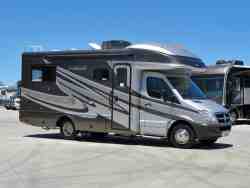The Deep Cycle Battery
In Your Motorhome
- A deep cycle battery bank and a good charging system will allow you to enjoy the great outdoors without having to rely on the 115V AC grid. It will get you off of the grid and into remote locations. The trick is to do this while keeping from
unnecessarily draining your batteries sooner than
you should. Eighty-five percent of all 12 volt batteries manufactured in the United States die before they should.
- Flooded Cell RV batteries come in two configurations that have similar dimensions but have very different applications. It is important to understand the normal charge/discharge cycles involved with a particular type of deep cycle battery's operation. These cycles will boil out the electrolyte causing failure unless distilled water can be re-introduced into the individual cells.
- Open Cell RV batteries have a pop off cap installed above each cell allowing access to the individual cells. This makes it possible to add distilled water, if necessary. This factor, along with thicker cell plates, makes it a good choice for duty as a deep cycle battery. This battery can be 6 V DC and 12 V DC.
- Maintenance Free RV batteries have a uniform top with no openings other than a small vent hole on each cell. This makes it impossible to add distilled water.
This lack of service openings to the individual cells, along with it having thinner cell plates, makes this type of battery unsuitable for your RV needs. This is a 12 V DC battery that is used extensively as an auto starting battery.
Of A Lack Of Proper Battery Maintenance

It seems that we have a problem with both are RV battery maintenance, and car battery maintenance. This page is focusing on deep cycle RV battery maintenance. Most of the car battery maintenance is the same as the deep cycle RV battery maintenance. Only charging and discharge cycles differ.
Our So, how do we become the fifteen percent that enjoy the full potential of our big house batteries? How do we get the most out of our deep cycle battery.
Why am I focusing on this deep cycle battery issue? Well, some locations limit your generating capacity to pretty much midday use. This means that you must have enough battery power in your rig to get you through the non-generating times of night.
Unless you you only go to RV parks that have plenty of power, or like to boondock out in the middle of nowhere where you can run your gen-set anytime you desire, you have to pay attention to the rules governing your surroundings.
All Class C Motorhomes will have a deep cycle battery bank consisting of one or more batteries that will be constructed of lead acid and will produce 12V DC.
A word of caution is needed here… a deep cycle battery is very dangerous. These things contain a sulfuric acid electrolyte (75% distilled water and 25% sulfuric acid), which is a corrosive liquid.
This acid can emit flammable hydrogen gas… think Hindenburg. Always be sure you and your deep cycle battery are in a well-ventilated space.
You do not want to smoke around these things, and avoid making any sparks or open flames. If you do get acid on you, dilute it down immediately with lots and lots of cold water.
You should ALWAYS wear safety glasses and protective clothing when cleaning or doing maintenance around a deep cycle battery.
that make up a Deep Cycle Battery bank
There are three types of lead acid deep cycle RV batteries available today: They are Flooded Cell, Gel, and Absorbed Gas Mat (AGM):
- Gel Cells use a gel-type substance as a thickening agent that prevents stratification due to the inability of electrolyte movement. All batteries have a mixture of 25% acid and 75% water.
When stratification occurs, the battery acid wants to separate and settle at the bottom of the battery. When this separation occurs, this causes a sulfur build-up on the plates. This, in turn, will decrease the battery's charging potential. It simply won't hold as strong of a charge.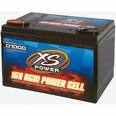
- They are used to prevent the possibility of potential spillage of the electrolytic substance in off-road and marine applications or when there is a likelihood of severe, un-leveled, or rough activity.
- They are a sealed unit. This makes sense when you think about it because there is no liquid. Therefore, you have no need to replace it.
- They are used to prevent the possibility of potential spillage of the electrolytic substance in off-road and marine applications or when there is a likelihood of severe, un-leveled, or rough activity.
Controlling the charge voltage is very important in any gel battery. They will require a slightly lower voltage than your standard flooded cell.
This is to prevent the irreplaceable electrolyte from boiling out.
Also, the rate of charge has to be slower. A sloppy charging technique will quickly destroy this unit.
I think the trick here is that if you really want a maintenance free unit, just make sure you have a charger that is designed to charge this gel. You don't want to wing it!
- An AGM Battery is like a gel battery on steroids.
- It can do anything a gel can do, only better. It is the latest and greatest technology available in the lead acid arena.
- It uses a fiberglass-like substance to act as a separator and works well holding the electrolyte in place.
- Everything listed above about the gel applies to the AGM with the exception of charge rate.
- They are very cool! AGM's use the same charge rate and voltage requirements as the flooded cell units, and they are considered drop in-replacements.
- It can do anything a gel can do, only better. It is the latest and greatest technology available in the lead acid arena.
Most people still use the good old wet cells in 12 and 6 volt configurations. So I'm going focus on this type of unit. However, there is a lot of information about AGM and gels out there if you want to go in that direction.
12V deep cycle batteries are sized in groups. They can come in sizes ranging from the Group 24 (70-85 amp-hours) up to Group 31 (95-125 amp-hours). If you use more than one 12V battery, always connect them in a parallel configuration.
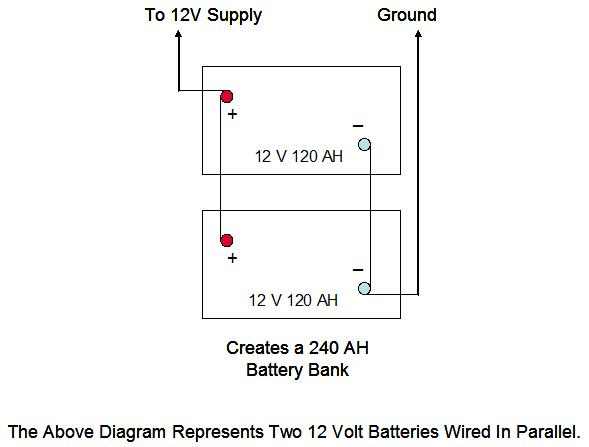
In general, if you have the room and weight capacity, you want to use the largest group size deep cycle battery available. This will almost always give you greater amps potential.
A popular alternative is to use a couple of 6V golf cart batteries (like the T-105) wired-in series. This will produce a strong 12V DC. Golf cart sized units have a true deep cycle, and they have thicker cell plates. The rule is... the thicker the plates, the better the deep cycle battery.
Trojan makes the T-105; and because you have to use these 6V units in groups of two, you will end up with 180 to 220 amp-hour per pair. This would give you up to a 440 amp-hour rating if you were to use four of them. When you go off the grid, you want the most amps that you can have. It makes life so much less stressful.
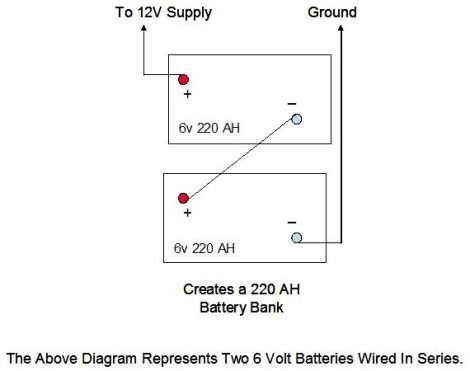
Most of the Class C Motorhome owners that use the six-volt system find the T-105 to be the “gold standard”. This Trojan battery is very reliable with proper maintenance and care.
Some think it is a little pricey at about $130.00 give or take. I have, however, read on the forums that you can get this T-105 under a different branding.
According to Consumers Reports, there are only three companies making batteries in the U.S.: Johnson Controls, Exide, and East Penn, which build them to retailer specifications.
However, they will make them under different brands. For example, Costco carries one with its own brand name of Kirkland; and "in form, fit, and function" it will perform as well as the T-105 with proper maintenance.
There are tons of information available at sites like http://www.rv.net/forum/. Feel free to go and ask questions, and you will get your answers. You may also provide information that could help others.
As I've already mentioned, your Class C Motorhome has two separate and distinctly different types of electricity. The stuff your generator and shore power (the grid) puts out is 115V AC, or when paired up with an inverter, solar panels , or even wind, it will produce 12V DC.
- DC simply means that your current wants to flow in one direction, creating an electron flow from negative to positive.
- AC, or Alternating Current, reverses its electron flow (electricity) at regularly recurring intervals. In this country, it will do this at 60 times a second (60 Hz).
It is important, however, that you understand that not all electricity is the same. AC electrical appliances are designed to be used with specific electrical grids.
When you are traveling, you may experience issues with compatibility using certain appliances and mobile devices with the available shore power.
For most Class C Motorhome owners, this information will only apply to those who go further south than Mexico to parts of Central and South America.
The AC electrical grid in North America (the United States, Canada, and Mexico) is substantially different than the majority of the rest of the world.
Its electricity is 115 V AC at 60 Hz per second. Almost everywhere else uses the metric electrical supply system, which is rated at 220/240 V AC at 50 Hz per second.
This information would only be important for you if you were to travel, say to Europe, Asia, Australia, or south of Mexico and wanted to bring mobile & electrical devices such as a coffee pot, hair dryer, some types of computers, phone chargers, etc. Even in the good old US of A, electrical power is not necessarily the same everywhere you go.
You should always test any electrical source before you plug it into your Class C Motorhome.
There can always be polarity issues, low voltages (brown outs), or even high voltages. You want your AC to stay in a range of between 115 V AC and 120 V AC. If you go out of this range, it is possible to damage certain electrical components.

Return To Top Of Page
Leave Your Deep Cycle Battery: Can it get you off of the grid? Page, And Aftermarket Class C Motorhome Accessories Can Improve
Your Rig's Performance!
Leave Your Deep Cycle RV Battery: Can it get you off of the grid? And Return To to Class C Motorhome: How To Achieve The
Maximum RV Lifestyle!
Your Stories
Onan AC Generator Wouldn't Start
1995 Tioga Montara Had a Leak - Ouch!
A Simple Way To Put An Elecrtrical Thermostat On A Small Space Heater In A Truck Camper!
A Great Destinaton, With An Unexpected Outcome!
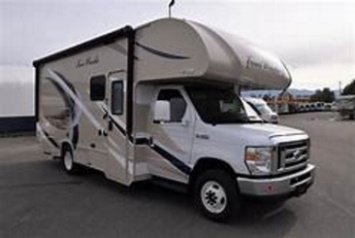
2018 Thor 21F Four Winds Class C Motorhome
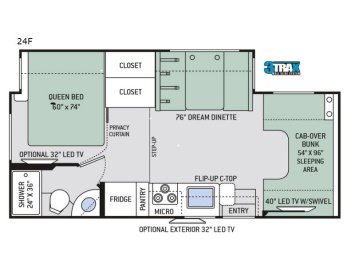
2018 Thor 21F Four Winds Class C Motorhome
2010 Fleetwood Pulse 24D
Class C Motorhome
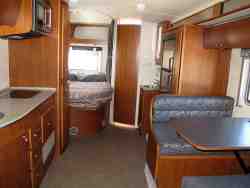
2010 Fleetwood Pulse 24D
Class C Motorhome
Above Graphics Courtesy of:
http://www.DeMartini.com
| Gasoline Prices |






